英语中的修辞手法(英语专业)
- 格式:doc
- 大小:56.00 KB
- 文档页数:7
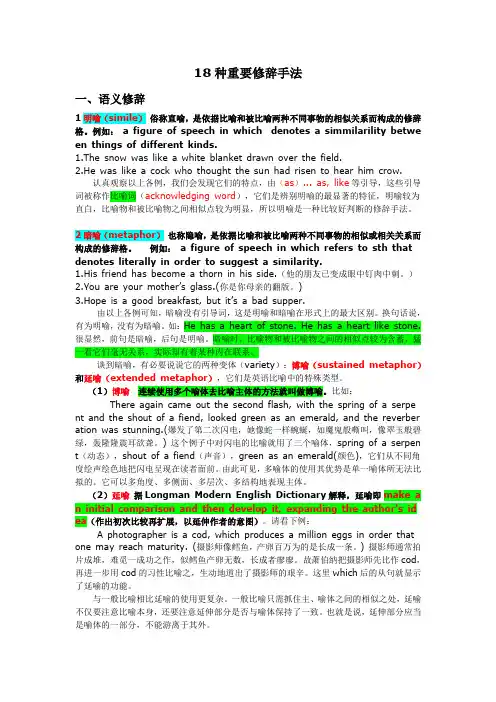
18种重要修辞手法一、语义修辞1明喻(simile)俗称直喻,是依据比喻和被比喻两种不同事物的相似关系而构成的修辞格。
例如:a figure of speech in which denotes a simmilarility betwe en things of different kinds.1.The snow was like a white blanket drawn over the field.2.He was like a cock who thought the sun had risen to hear him crow.认真观察以上各例,我们会发现它们的特点,由(as)... as, like等引导,这些引导词被称作比喻词(acknowledging word),它们是辨别明喻的最显著的特征,明喻较为直白,比喻物和被比喻物之间相似点较为明显,所以明喻是一种比较好判断的修辞手法。
2暗喻(metaphor)也称隐喻,是依据比喻和被比喻两种不同事物的相似或相关关系而构成的修辞格。
例如:a figure of speech in which refers to sth that denotes literally in order to suggest a similarity.1.His friend has become a thorn in his side.(他的朋友已变成眼中钉肉中刺。
)2.You are your mother’s glass.(你是你母亲的翻版。
)3.Hope is a good breakfast, but it’s a bad supper.由以上各例可知,暗喻没有引导词,这是明喻和暗喻在形式上的最大区别。
换句话说,有为明喻,没有为暗喻。
如:He has a heart of stone. He has a heart like stone.很显然,前句是暗喻,后句是明喻。
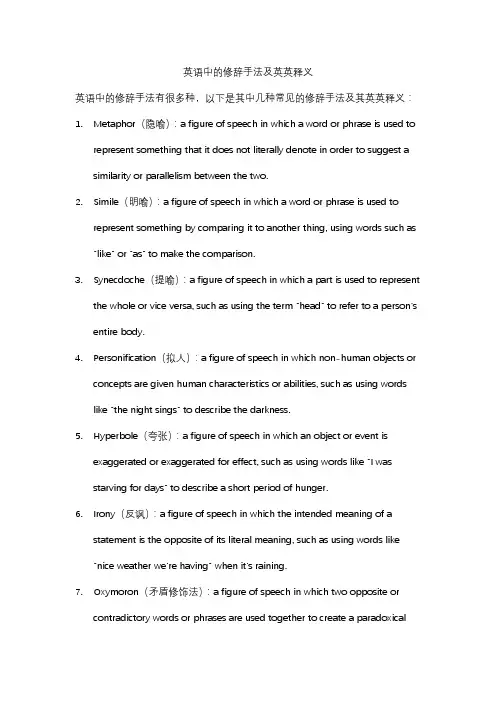
英语中的修辞手法及英英释义英语中的修辞手法有很多种,以下是其中几种常见的修辞手法及其英英释义:1.Metaphor(隐喻):a figure of speech in which a word or phrase is used torepresent something that it does not literally denote in order to suggest a similarity or parallelism between the two.2.Simile(明喻):a figure of speech in which a word or phrase is used torepresent something by comparing it to another thing, using words such as "like" or "as" to make the comparison.3.Synecdoche(提喻):a figure of speech in which a part is used to representthe whole or vice versa, such as using the term "head" to refer to a person's entire body.4.Personification(拟人):a figure of speech in which non-human objects orconcepts are given human characteristics or abilities, such as using words like "the night sings" to describe the darkness.5.Hyperbole(夸张):a figure of speech in which an object or event isexaggerated or exaggerated for effect, such as using words like "I wasstarving for days" to describe a short period of hunger.6.Irony(反讽):a figure of speech in which the intended meaning of astatement is the opposite of its literal meaning, such as using words like"nice weather we're having" when it's raining.7.Oxymoron(矛盾修饰法):a figure of speech in which two opposite orcontradictory words or phrases are used together to create a paradoxicaleffect, such as using words like "bittersweet" to describe a mixed feeling of happiness and sadness.这些修辞手法都可以增强语言的表达力,帮助传达更深刻的意义。
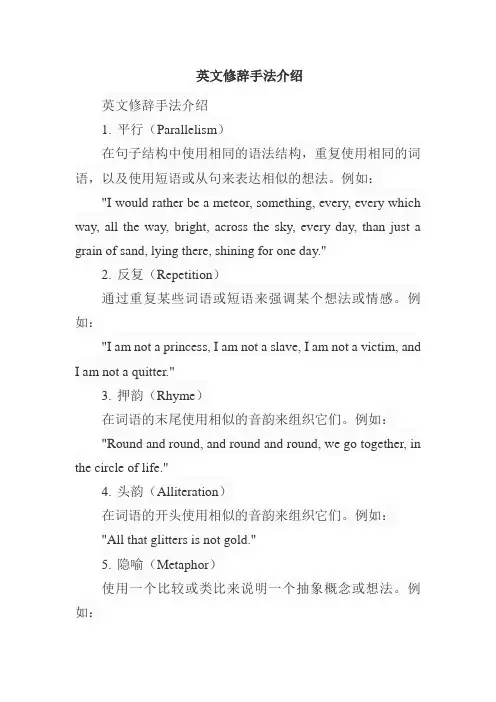
英文修辞手法介绍英文修辞手法介绍1. 平行(Parallelism)在句子结构中使用相同的语法结构,重复使用相同的词语,以及使用短语或从句来表达相似的想法。
例如:"I would rather be a meteor, something, every, every which way, all the way, bright, across the sky, every day, than just a grain of sand, lying there, shining for one day."2. 反复(Repetition)通过重复某些词语或短语来强调某个想法或情感。
例如:"I am not a princess, I am not a slave, I am not a victim, andI am not a quitter."3. 押韵(Rhyme)在词语的末尾使用相似的音韵来组织它们。
例如:"Round and round, and round and round, we go together, in the circle of life."4. 头韵(Alliteration)在词语的开头使用相似的音韵来组织它们。
例如:"All that glitters is not gold."5. 隐喻(Metaphor)使用一个比较或类比来说明一个抽象概念或想法。
例如:"He is a lion in battle."6. 明喻(Simile)使用像“像”或“如同”这样的词语来比较两个不同的事物或概念。
例如:"She sings like a bird."7. 反问(Rhetorical question)使用一个问题来表达一个陈述或观点,而不是提出真正的问题。
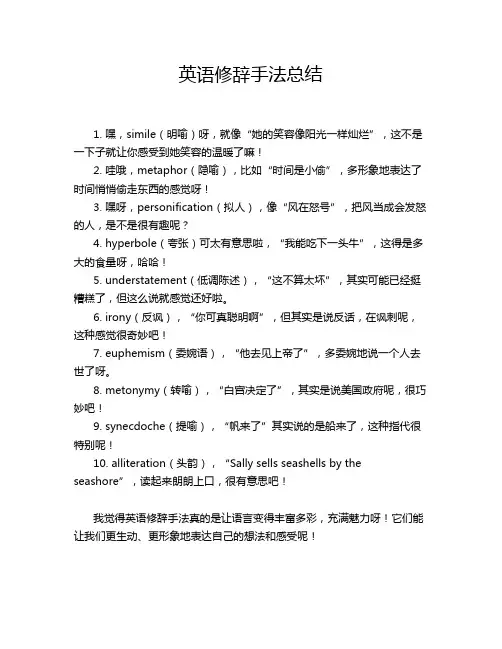
英语修辞手法总结
1. 嘿,simile(明喻)呀,就像“她的笑容像阳光一样灿烂”,这不是一下子就让你感受到她笑容的温暖了嘛!
2. 哇哦,metaphor(隐喻),比如“时间是小偷”,多形象地表达了时间悄悄偷走东西的感觉呀!
3. 嘿呀,personification(拟人),像“风在怒号”,把风当成会发怒的人,是不是很有趣呢?
4. hyperbole(夸张)可太有意思啦,“我能吃下一头牛”,这得是多大的食量呀,哈哈!
5. understatement(低调陈述),“这不算太坏”,其实可能已经挺糟糕了,但这么说就感觉还好啦。
6. irony(反讽),“你可真聪明啊”,但其实是说反话,在讽刺呢,这种感觉很奇妙吧!
7. euphemism(委婉语),“他去见上帝了”,多委婉地说一个人去世了呀。
8. metonymy(转喻),“白宫决定了”,其实是说美国政府呢,很巧妙吧!
9. synecdoche(提喻),“帆来了”其实说的是船来了,这种指代很特别呢!
10. alliteration(头韵),“Sally sells seashells by the seashore”,读起来朗朗上口,很有意思吧!
我觉得英语修辞手法真的是让语言变得丰富多彩,充满魅力呀!它们能让我们更生动、更形象地表达自己的想法和感受呢!。
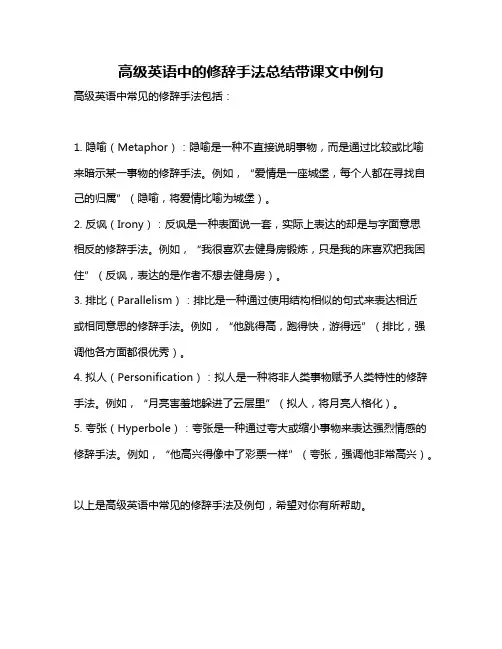
高级英语中的修辞手法总结带课文中例句
高级英语中常见的修辞手法包括:
1. 隐喻(Metaphor):隐喻是一种不直接说明事物,而是通过比较或比喻来暗示某一事物的修辞手法。
例如,“爱情是一座城堡,每个人都在寻找自己的归属”(隐喻,将爱情比喻为城堡)。
2. 反讽(Irony):反讽是一种表面说一套,实际上表达的却是与字面意思
相反的修辞手法。
例如,“我很喜欢去健身房锻炼,只是我的床喜欢把我困住”(反讽,表达的是作者不想去健身房)。
3. 排比(Parallelism):排比是一种通过使用结构相似的句式来表达相近
或相同意思的修辞手法。
例如,“他跳得高,跑得快,游得远”(排比,强调他各方面都很优秀)。
4. 拟人(Personification):拟人是一种将非人类事物赋予人类特性的修辞手法。
例如,“月亮害羞地躲进了云层里”(拟人,将月亮人格化)。
5. 夸张(Hyperbole):夸张是一种通过夸大或缩小事物来表达强烈情感的修辞手法。
例如,“他高兴得像中了彩票一样”(夸张,强调他非常高兴)。
以上是高级英语中常见的修辞手法及例句,希望对你有所帮助。
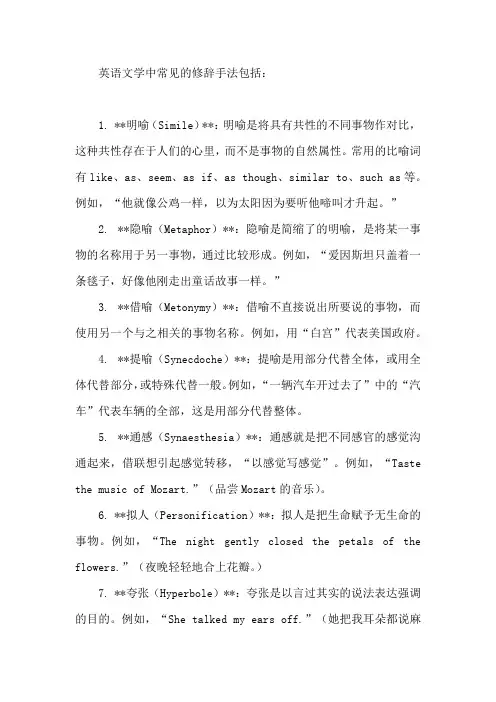
英语文学中常见的修辞手法包括:1. **明喻(Simile)**:明喻是将具有共性的不同事物作对比,这种共性存在于人们的心里,而不是事物的自然属性。
常用的比喻词有like、as、seem、as if、as though、similar to、such as等。
例如,“他就像公鸡一样,以为太阳因为要听他啼叫才升起。
”2. **隐喻(Metaphor)**:隐喻是简缩了的明喻,是将某一事物的名称用于另一事物,通过比较形成。
例如,“爱因斯坦只盖着一条毯子,好像他刚走出童话故事一样。
”3. **借喻(Metonymy)**:借喻不直接说出所要说的事物,而使用另一个与之相关的事物名称。
例如,用“白宫”代表美国政府。
4. **提喻(Synecdoche)**:提喻是用部分代替全体,或用全体代替部分,或特殊代替一般。
例如,“一辆汽车开过去了”中的“汽车”代表车辆的全部,这是用部分代替整体。
5. **通感(Synaesthesia)**:通感就是把不同感官的感觉沟通起来,借联想引起感觉转移,“以感觉写感觉”。
例如,“Taste the music of Mozart.”(品尝Mozart的音乐)。
6. **拟人(Personification)**:拟人是把生命赋予无生命的事物。
例如,“The night gently closed the petals of the flowers.”(夜晚轻轻地合上花瓣。
)7. **夸张(Hyperbole)**:夸张是以言过其实的说法表达强调的目的。
例如,“She talked my ears off.”(她把我耳朵都说麻了。
)这些修辞手法在英语文学中被广泛使用,可以帮助作者更生动、形象地表达自己的想法和感受。
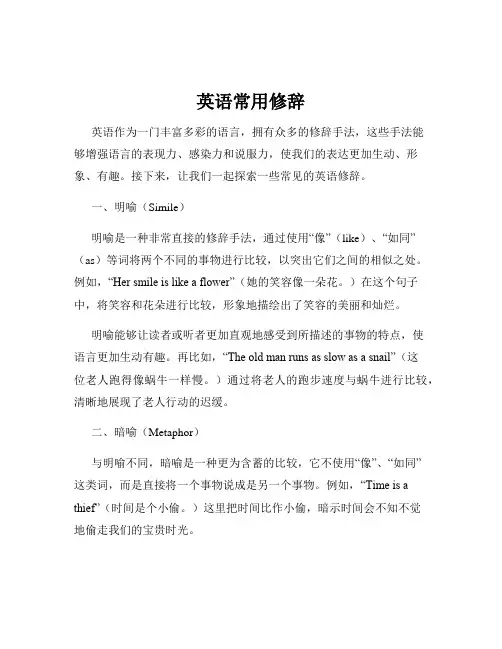
英语常用修辞英语作为一门丰富多彩的语言,拥有众多的修辞手法,这些手法能够增强语言的表现力、感染力和说服力,使我们的表达更加生动、形象、有趣。
接下来,让我们一起探索一些常见的英语修辞。
一、明喻(Simile)明喻是一种非常直接的修辞手法,通过使用“像”(like)、“如同”(as)等词将两个不同的事物进行比较,以突出它们之间的相似之处。
例如,“Her smile is like a flower”(她的笑容像一朵花。
)在这个句子中,将笑容和花朵进行比较,形象地描绘出了笑容的美丽和灿烂。
明喻能够让读者或听者更加直观地感受到所描述的事物的特点,使语言更加生动有趣。
再比如,“The old man runs as slow as a snail”(这位老人跑得像蜗牛一样慢。
)通过将老人的跑步速度与蜗牛进行比较,清晰地展现了老人行动的迟缓。
二、暗喻(Metaphor)与明喻不同,暗喻是一种更为含蓄的比较,它不使用“像”、“如同”这类词,而是直接将一个事物说成是另一个事物。
例如,“Time is a thief”(时间是个小偷。
)这里把时间比作小偷,暗示时间会不知不觉地偷走我们的宝贵时光。
暗喻能够使语言更加简洁有力,给人留下深刻的印象。
又如,“The classroom is a zoo”(教室是个动物园。
)形象地表达出教室里的喧闹和混乱。
三、拟人(Personification)拟人是赋予非人类的事物以人类的特征、行为或情感。
比如,“The wind whispered through the trees”(风在树林中低语。
)风本是没有生命的自然现象,但通过“低语”这个人类的动作,使其具有了人的特质,让读者更能感受到风的轻柔。
“The stars danced playfully in the sky”(星星在天空中欢快地跳舞。
)将星星的闪烁描绘成跳舞,充满了活泼和欢乐的氛围。
拟人手法可以让我们对周围的世界产生更加亲切和生动的感受。
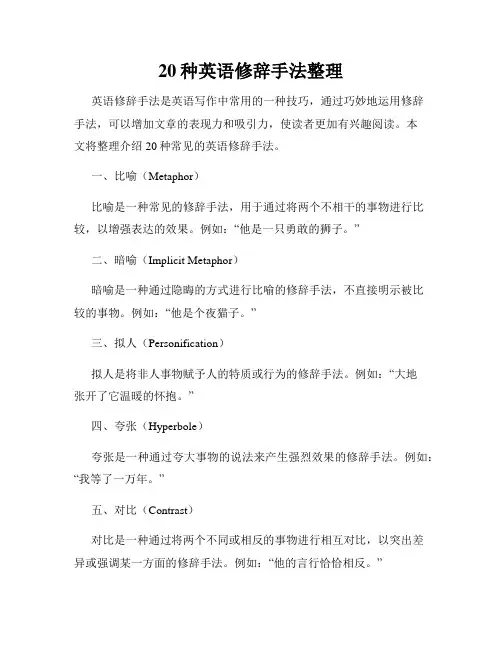
20种英语修辞手法整理英语修辞手法是英语写作中常用的一种技巧,通过巧妙地运用修辞手法,可以增加文章的表现力和吸引力,使读者更加有兴趣阅读。
本文将整理介绍20种常见的英语修辞手法。
一、比喻(Metaphor)比喻是一种常见的修辞手法,用于通过将两个不相干的事物进行比较,以增强表达的效果。
例如:“他是一只勇敢的狮子。
”二、暗喻(Implicit Metaphor)暗喻是一种通过隐晦的方式进行比喻的修辞手法,不直接明示被比较的事物。
例如:“他是个夜猫子。
”三、拟人(Personification)拟人是将非人事物赋予人的特质或行为的修辞手法。
例如:“大地张开了它温暖的怀抱。
”四、夸张(Hyperbole)夸张是一种通过夸大事物的说法来产生强烈效果的修辞手法。
例如:“我等了一万年。
”五、对比(Contrast)对比是一种通过将两个不同或相反的事物进行相互对比,以突出差异或强调某一方面的修辞手法。
例如:“他的言行恰恰相反。
”六、排比(Parallelism)排比是一种通过对句子或短语进行平行结构的修辞手法,以强调重点或增加语句的节奏感。
例如:“奋斗,拼搏,追求,努力。
”七、倒装(Inversion)倒装是一种颠倒语序的修辞手法,常常用于疑问句或为了强调某一部分。
例如:“Never have I seen such a beautiful sunset.”八、反问(Rhetorical Question)反问是一种用疑问句的形式表达肯定或否定的修辞手法,常用于强调某一观点或引起读者思考。
例如:“难道你不想成功吗?”九、比较(Comparison)比较是通过将两个事物进行对比,以凸显共同点或差异的修辞手法。
例如:“学习就像是爬山,充满了艰辛和挑战。
”十、设问(Hypophora)设问是一种在文章中提出问题,并在下文中进行回答的修辞手法,常用于引起读者的关注和思考。
例如:“你知道成功的秘诀是什么吗?答案很简单——努力。
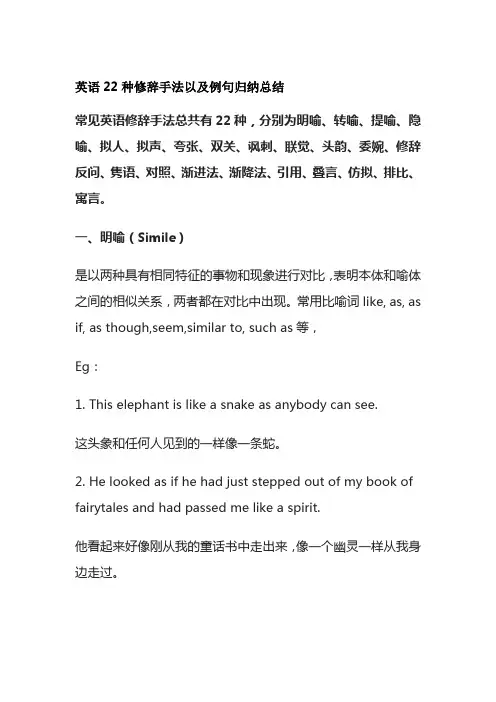
英语22种修辞手法以及例句归纳总结常见英语修辞手法总共有22种,分别为明喻、转喻、提喻、隐喻、拟人、拟声、夸张、双关、讽刺、联觉、头韵、委婉、修辞反问、隽语、对照、渐进法、渐降法、引用、叠言、仿拟、排比、寓言。
一、明喻(Simile)是以两种具有相同特征的事物和现象进行对比,表明本体和喻体之间的相似关系,两者都在对比中出现。
常用比喻词like, as, as if, as though,seem,similar to, such as等,Eg:1. This elephant is like a snake as anybody can see.这头象和任何人见到的一样像一条蛇。
2. He looked as if he had just stepped out of my book of fairytales and had passed me like a spirit.他看起来好像刚从我的童话书中走出来,像一个幽灵一样从我身边走过。
3. It has long leaves that sway in the wind like slim fingers reaching to touch something.它那长长的叶子在风中摆动,好像伸出纤细的手指去触摸什么东西似的。
二、隐喻(Metaphor)这种比喻不通过比喻词进行,而是直接将用事物当作乙事物来描写,甲乙两事物之间的联系和相似之处是暗含的。
Eg:1、The diamond department was the heart and center of the store.钻石部是商店的心脏和核心。
2. He is a pig.他简直是头猪。
(比喻:他是一个像猪一般的人,指肮脏,贪吃的人。
)3. She is a woman with a stony heart.她是一个铁石心肠的女人。
(比喻:这个女人冷酷无情。
)4.Mark Twain is a mirror of America.马克•吐温是美国的一面镜子。
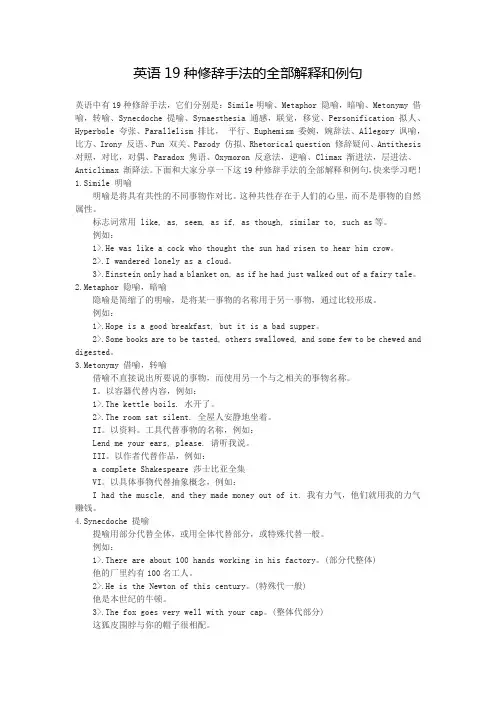
英语19种修辞手法的全部解释和例句英语中有19种修辞手法,它们分别是:Simile明喻、Metaphor 隐喻,暗喻、Metonymy 借喻,转喻、Synecdoche 提喻、Synaesthesia 通感,联觉,移觉、Personification 拟人、Hyperbole 夸张、Parallelism 排比,平行、Euphemism 委婉,婉辞法、Allegory 讽喻,比方、Irony 反语、Pun 双关、Parody 仿拟、Rhetorical question 修辞疑问、Antithesis 对照,对比,对偶、Paradox 隽语、Oxymoron 反意法,逆喻、Climax 渐进法,层进法、Anticlimax 渐降法。
下面和大家分享一下这19种修辞手法的全部解释和例句,快来学习吧!1.Simile 明喻明喻是将具有共性的不同事物作对比。
这种共性存在于人们的心里,而不是事物的自然属性。
标志词常用 like, as, seem, as if, as though, similar to, such as等。
例如:1>.He was like a cock who thought the sun had risen to hear him crow。
2>.I wandered lonely as a cloud。
3>.Einstein only had a blanket on, as if he had just walked out of a fairy tale。
2.Metaphor 隐喻,暗喻隐喻是简缩了的明喻,是将某一事物的名称用于另一事物,通过比较形成。
例如:1>.Hope is a good breakfast, but it is a bad supper。
2>.Some books are to be tasted, others swallowed, and some few to be chewed and digested。
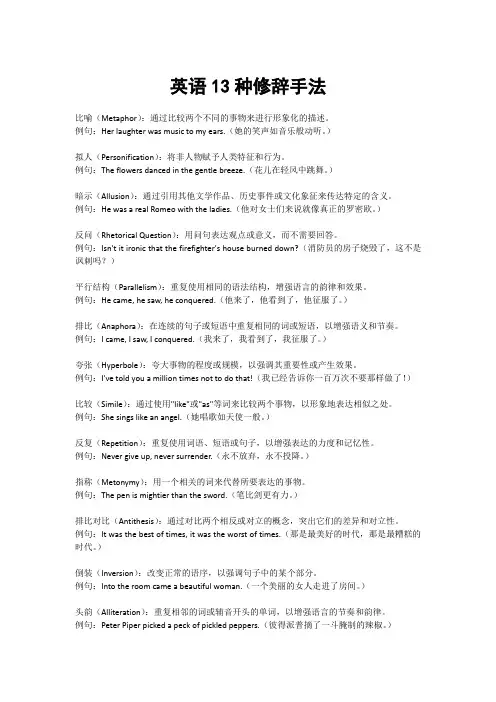
英语13种修辞手法比喻(Metaphor):通过比较两个不同的事物来进行形象化的描述。
例句:Her laughter was music to my ears.(她的笑声如音乐般动听。
)拟人(Personification):将非人物赋予人类特征和行为。
例句:The flowers danced in the gentle breeze.(花儿在轻风中跳舞。
)暗示(Allusion):通过引用其他文学作品、历史事件或文化象征来传达特定的含义。
例句:He was a real Romeo with the ladies.(他对女士们来说就像真正的罗密欧。
)反问(Rhetorical Question):用问句表达观点或意义,而不需要回答。
例句:Isn't it ironic that the firefighter's house burned down?(消防员的房子烧毁了,这不是讽刺吗?)平行结构(Parallelism):重复使用相同的语法结构,增强语言的韵律和效果。
例句:He came, he saw, he conquered.(他来了,他看到了,他征服了。
)排比(Anaphora):在连续的句子或短语中重复相同的词或短语,以增强语义和节奏。
例句:I came, I saw, I conquered.(我来了,我看到了,我征服了。
)夸张(Hyperbole):夸大事物的程度或规模,以强调其重要性或产生效果。
例句:I've told you a million times not to do that!(我已经告诉你一百万次不要那样做了!)比较(Simile):通过使用"like"或"as"等词来比较两个事物,以形象地表达相似之处。
例句:She sings like an angel.(她唱歌如天使一般。
)反复(Repetition):重复使用词语、短语或句子,以增强表达的力度和记忆性。
英文中的修辞手法英文中有许多修辞手法,这些手法通过运用特定的语言技巧,可以增强文学作品的表达力和感染力。
以下是一些常见的英文修辞手法:比喻(Metaphor):将两个不同的事物进行比较,以强调它们之间的相似之处,而不使用"like"或"as"。
例如:“时间是一把无情的剑。
”拟人(Personification):赋予非人物以人的特质或行为,使其更具生动性。
例如:“风儿轻轻地低语。
”象征(Symbolism):使用一个事物、符号或象征来代表另一个抽象概念。
例如:“燕子在文学中通常象征着春天和希望。
”暗喻(Metonymy):用一个与所指实体有着密切关联的词汇来替代它。
例如:“白宫发布了一份声明”中的“白宫”代表美国政府。
排比(Parallelism):通过使用相似的句式或结构,强调语言的平衡和韵律。
例如:“我不怕困难,我不怕失败,我不怕挑战。
”双关语(Pun):利用一个词汇项的多义性或相似的发音来制造幽默或引起思考。
例如:“时间飞逝,果然很‘秒’。
”讽刺(Irony):通过言辞上的反讽,表达与字面意义相反的意思。
例如:“这个‘伟大’的计划居然失败了。
”悬念(Suspense):通过保持某种信息的不明确,刺激读者的兴趣,以激发紧张感。
例如:“她打开门,里面的一切都让她惊呆了。
”对仗(Antithesis):将相对或对立的思想或概念通过并列的结构进行强调。
例如:“昨夜寒风凛冽,今朝暖阳明媚。
”比较(Simile):将两个事物通过使用"like"或"as"进行比较,以突显它们之间的相似之处。
例如:“她如同一朵盛开的花。
”这些修辞手法可以单独使用,也可以结合在一起,创造出更为复杂和富有表现力的文学效果。
作家通常根据他们的写作目的,选择最适合表达自己意图的修辞手法。
英语修辞手法的解释和例句1.Simile 明喻明喻是将具有共性的不同事物作对比.这种共性存在于人们的心里,而不是事物的自然属性.标志词常用like, as, seem, as if, as though, similar to, such as等.例如:1>.He was like a cock who thought the sun had risen to hear him crow.2>.I wandered lonely as a cloud.3>.Einstein only had a blanket on, as if he had just walked out of a fairy tale.2.Metaphor 隐喻,暗喻隐喻是简缩了的明喻,是将某一事物的名称用于另一事物,通过比较形成.例如:1>.Hope is a good breakfast, but it is a bad supper.2>.Some books are to be tasted, others swallowed, and some few to be chewed and digested.3.Metonymy 借喻,转喻借喻不直接说出所要说的事物,而使用另一个与之相关的事物名称.I.以容器代替内容,例如:1>.The kettle boils. 水开了.2>.The room sat silent. 全屋人安静地坐着.II.以资料.工具代替事物的名称,例如:Lend me your ears, please. 请听我说.III.以作者代替作品,例如:a complete Shakespeare 莎士比亚全集VI.以具体事物代替抽象概念,例如:I had the muscle, and they made money out of it. 我有力气,他们就用我的力气赚钱.4.Synecdoche 提喻提喻用部分代替全体,或用全体代替部分,或特殊代替一般.例如:1>.There are about 100 hands working in his factory.(部分代整体)他的厂里约有100名工人.2>.He is the Newton of this century.(特殊代一般)他是本世纪的牛顿.3>.The fox goes very well with your cap.(整体代部分)这狐皮围脖与你的帽子很相配.5.Synaesthesia 通感,联觉,移觉这种修辞法是以视.听.触.嗅.味等感觉直接描写事物.通感就是把不同感官的感觉沟通起来,借联想引起感觉转移,“以感觉写感觉”。
英语专业四级语法修辞手法修辞手法是一种常用于英语写作中的技巧,它可以提高文学作品的表现力和吸引力。
尤其对于英语专业四级考试来说,掌握语法修辞手法对于写作和阅读都至关重要。
本文将介绍一些常见的英语语法修辞手法,并通过例子来说明它们的应用。
一、重复重复是修辞手法中最简单也是最常用的一种。
通过重复某个词语或短语,可以强调特定的意思或情感。
例如:1. "The house was old, old and dilapidated."这里通过连续两次重复“old”,强调房子的破旧。
2. "Never give up. Never surrender."这里通过连续两次重复“Never”,强调坚持和不屈不挠的精神。
二、对比对比是修辞手法中用于突出相似或相反事物之间差异的一种方法。
通过对照,可以使文章更生动有趣。
例如:1. "He is as brave as a lion, but as gentle as a lamb."这里通过对比狮子和羔羊的特点,形象地描述一个人的勇敢和温柔。
2. "The night was as dark as coal, while the day was as bright as the sun."这里通过对比黑夜和白天的明暗程度,突出它们的明显差异。
三、排比排比是一种修辞手法,通过将一系列类似的词或短语排列在一起,可以增强修辞效果。
例如:1. "I came, I saw, I conquered."这里通过排比并列的方式,强调了作者的胜利。
2. "We worked hard, we played hard, we laughed hard."这里通过排比的方式,强调了工作、娱乐和笑声的强烈程度。
四、倒装句倒装句是一种改变正常语序的句子结构,常用于强调特定的词或创造一种文学效果。
高级英语1修辞手法汇总修辞手法是英语写作中常用的一种技巧,通过运用修辞手法可以使文章更加生动、富有表现力,增强读者的阅读体验。
在高级英语写作中,修辞手法的运用尤为重要,它可以为文章赋予深度和风格,并提升文章的艺术性和说服力。
下面将介绍几种常见的修辞手法。
一、比喻(Metaphor)比喻是一种通过将一个事物与另一个事物相比较,以便更好地说明或形容某个概念或主题的修辞手法。
它常常用于描述抽象的概念,使之变得更加具体和形象。
例句:1. He is a lion in the battlefield.2. Her smile was a ray of sunshine on a cloudy day.二、拟人(Personification)拟人是一种将非人类的事物或抽象的概念赋予人类的特征和行为的修辞手法。
通过将这些非人类的事物拟人化,可以使文章更生动有趣,增强读者对其中事物的感知和理解。
例句:1. The wind whispered through the trees.2. The flowers danced in the breeze.三、夸张(Hyperbole)夸张是一种通过夸大事物的特征或情况来强调其重要性或影响力的修辞手法。
它常用于诗歌、演讲或幽默作品中,以引起读者的兴趣和共鸣。
例句:1. I've told you a million times not to do that!2. The line for the new iPhone was a mile long.四、反问(Rhetorical question)反问是一种不需要回答的问题,用于引起读者的思考或表达某种意义的修辞手法。
通过将一个问题直接提出,可以引起读者的兴趣和注意,并激发其对文章主题的思考。
例句:1. Do you really think I would believe such a ridiculous story?2. Can you imagine a world without music?五、排比(Parallelism)排比是一种通过重复并列的结构或类似的语法结构来增加修辞效果的修辞手法。
英语中常用的修辞手法英语中常用的修辞手法有以下几种:1. Simile(明喻):通过使用“like”或“as”等词将两个不同的事物进行比较,以突出它们的相似之处。
Example: Her eyes were like stars in the night sky.2. Metaphor(隐喻):将一个事物直接比作另一个事物,而不使用“like”或“as”等词。
Example: Life is a journey.3. Personification(拟人):赋予无生命的事物以人类的特征或行为。
Example: The wind whispered through the trees.4. Hyperbole(夸张):故意夸大或夸张某个事物的特征或程度。
Example: I could sleep for a year.5. Parallelism(排比):使用相同或相似的结构、语法或词汇来表达一个想法或主题。
Example: She is smart, talented, and beautiful.6. Alliteration(头韵):重复相同的声音或字母,以增强语言的韵律和节奏。
Example: The quick brown fox jumps over the lazy dog.7. Onomatopoeia(拟声):使用与所描述的声音相似的词汇来模拟声音。
Example: The clock tick-tocked in the quiet room.8. Repetition(重复):重复某个词汇或短语以增强语言的效果。
Example: Once upon a time, there was a princess who lived in a castle.9. Antithesis(对比):将两个相反的想法或概念放在一起进行对比。
Example: Love is an act of endless forgiveness, a tender look which becomes a habit.这些修辞手法可以帮助作者更生动、形象地表达自己的意思,增强语言的感染力和说服力。
英语的修辞手法英语的修辞手法有很多种,其中一些常见的修辞手法包括:1. 比喻(Metaphor): 指的是用一个事物来比喻另一个事物,从而使语言更加生动、形象。
例如,"She is a lioness in the office." (她是一只办公室中的母狮子。
)2. 拟人(Personification): 指的是将事物或概念拟人化,从而使语言更加生动、形象。
例如,"The mountains were dressed in white and the sky wept tears." (群山披上白色,天空流下泪水。
)3. 排比(Parallelism): 指的是用相似的结构来表达三个或以上的事物,从而使语言更加有力、优美。
例如,"To fish, to hunt, to plant, to harvest, to eat." (钓鱼,打猎,种植,收获,食用。
)4. 夸张(Hyperbole): 指的是用夸张的手法来表达一个事物或概念,从而使语言更加生动、形象。
例如,"She is as fast as lightning." (她快如闪电。
)5. 反问(Rhetorical Question): 指的是用问题的形式来表达一个观点或情感,从而增强语言的力量。
例如,"Isn't life beautiful, floating on the waves of life?" (生活难道不美好吗?在生命的波浪上漂浮。
)6. 讽刺(Satire): 指的是用讽刺的手法来表达对某人或某事的不满或轻蔑,从而引起读者的共鸣。
例如,"The CEO is such a genius that he can even solve the problems of his own company." (CEO如此天才,甚至能解决自己公司的问题。
英语修辞手法的解释和例句1.Simile 明喻明喻是将具有共性的不同事物作对比.这种共性存在于人们的心里,而不是事物的自然属性.标志词常用like, as, seem, as if, as though, similar to, such as等.例如:1>.He was like a cock who thought the sun had risen to hear him crow.2>.I wandered lonely as a cloud.3>.Einstein only had a blanket on, as if he had just walked out of a fairy tale.2.Metaphor 隐喻,暗喻隐喻是简缩了的明喻,是将某一事物的名称用于另一事物,通过比较形成.例如:1>.Hope is a good breakfast, but it is a bad supper.2>.Some books are to be tasted, others swallowed, and some few to be chewed and digested.3.Metonymy 借喻,转喻借喻不直接说出所要说的事物,而使用另一个与之相关的事物名称.I.以容器代替内容,例如:1>.The kettle boils. 水开了.2>.The room sat silent. 全屋人安静地坐着.II.以资料.工具代替事物的名称,例如:Lend me your ears, please. 请听我说.III.以作者代替作品,例如:a complete Shakespeare 莎士比亚全集VI.以具体事物代替抽象概念,例如:I had the muscle, and they made money out of it. 我有力气,他们就用我的力气赚钱.4.Synecdoche 提喻提喻用部分代替全体,或用全体代替部分,或特殊代替一般.例如:1>.There are about 100 hands working in his factory.(部分代整体)他的厂里约有100名工人.2>.He is the Newton of this century.(特殊代一般)他是本世纪的牛顿.3>.The fox goes very well with your cap.(整体代部分)这狐皮围脖与你的帽子很相配.5.Synaesthesia 通感,联觉,移觉这种修辞法是以视.听.触.嗅.味等感觉直接描写事物.通感就是把不同感官的感觉沟通起来,借联想引起感觉转移,“以感觉写感觉”。
通感技巧的运用,能突破语言的局限,丰富表情达意的审美情趣,起到增强文采的艺术效果。
比如:欣赏建筑的重复与变化的样式会联想到音乐的重复与变化的节奏;闻到酸的东西会联想到尖锐的物体;听到飘渺轻柔的音乐会联想到薄薄的半透明的纱子;又比如朱自清《荷塘月色》里的“ 微风过处送来缕缕清香,仿佛远处高楼上渺茫的歌声似的”。
例如:1>.The birds sat upon a tree and poured forth their lily like voice.(用视觉形容听觉,鸟落在树上,由它发出的声音联想到百合花)鸟儿落在树上,倾泻出百合花似的声音.2>.Taste the music of Mozart.(用嗅觉形容听觉)品尝Mozart的音乐.6.Personification 拟人拟人是把生命赋予无生命的事物.例如:1>.The night gently lays her hand at our fevered heads.(把夜拟人化)2>.I was very happy and could hear the birds singing in the woods.(把鸟拟人化)7.Hyperbole 夸张夸张是以言过其实的说法表达强调的目的.它可以加强语势,增加表达效果..例如:1>.I beg a thousand pardons.2>.Love you. You are the whole world to me, and the moon and the stars.3>.When she heard the bad news, a river of tears poured out.8.Parallelism 排比, 平行这种修辞法是把两个或两个以上的结构大体相同或相似,意思相关,语气一致的短语.句子排列成串,形成一个整体.例如:1>.No one can be perfectly free till all are free; no one can be perfectly moral till all are moral; no one can be perfectly happy till all are happy.2>.In the days when all these things are to be answered for, I summon you and yours, to the last of your bad race, to answer for them. In the days when all these things are to be answered for, I summon your brother, the worst of your bad race, to answer for them separately.9.Euphemism 委婉,婉辞法婉辞法指用委婉,文雅的方法表达粗恶,避讳的话.例如:1>.He is out visiting the necessary. 他出去方便一下.2>.His relation with his wife has not been fortunate. 他与妻子关系不融洽.3>.Deng Xiaoping passed away in 1997. (去世)10.Allegory 讽喻,比方(原意“寓言”)建立在假借过去或别处的事例与对象之上,传达暗示,影射或者讥讽现世各种现象的含义。
英文解释:an expressive style that uses fictional characters and events to describe some subject by suggestive resemblances; an extended metaphor 摘自英语专业《大学英语教程》一书这是一种源于希腊文的修辞法,意为"换个方式的说法".它是一种形象的描述,具有双重性,表层含义与真正意味的是两回事.例如:1>.Make the hay while the sun shines.表层含义:趁着出太阳的时候晒草真正意味:趁热打铁2>.It's time to turn plough into sword.表层含义:是时候把犁变成剑11.Irony 反语反语指用相反意义的词来表达意思的作文方式.如在指责过失.错误时,用赞同过失的说法,而在表扬时,则近乎责难的说法.1>.It would be a fine thing indeed not knowing what time it was in the morning.早上没有时间观念还真是一件好事啊(真实含义是应该明确早上的时间观念)2>"Of course, you only carry large notes, no small change on you. "the waiter said to the beggar.Sarcasm: (讽刺)Sarcasm is a strong form of irony. It attacks in a taunting and bitter manner, and its aim is to disparage, ridicule and wound the feelings of the subject attacked. For example, laws are like cobwebs, which may catch small flies, but let wasps break through.I love being married. It’s so great to find that one special person you want to annoy for the rest of your lifeI'd insult you, but you're not bright enough to notice.Not all men are annoying. Some are dead.Ridicule 嘲弄Is unkind laughter or remarks intended to make someone or something seem stupid.Eg. He mopped his bald dome in silence.Bryan, ageing and paunchy, was assisted.Innuendo: (暗讽)It is a mild form of irony, hinting in a rather roundabout (曲折)way at something disparaging(不一致) or uncomplimentary(不赞美) to the person or subject mentioned.For example, the weatherman said it would be worm. He must take his readings in a bathroom.Innuendo and irony differ from each other. With irony, the intended meaning is explicit: it is expressed by the opposite of the literal meaning of the word used. In contrast, with innuendo, the intended meaning is implicit and the understanding of it depends on the context. That’s why innuendo is also called “a mild irony”. Com pare the innuendo remarks with the plain statement in the brackets.12.Pun 双关双关就是用一个词在句子中的双重含义,借题发挥.作出多种解释,旁敲侧击,从而达到意想不到的幽默.滑稽效果.它主要以相似的词形.词意和谐音的方式出现.例如:1>.She is too low for a high praise, too brown for a fair praise and too little fora great praise.2>.An ambassador is an honest man who lies abroad for the good of his country.3>.If we don't hang together, we shall hang separately.13.Parody 仿拟这是一种模仿名言.警句.谚语,改动其中部分词语,从而使其产生新意的修辞.例如:1>.Rome was not built in a day, nor in a year.2>.A friend in need is a friend to be avoided.3>.If you give a girl an inch nowadays she will make address of it.14.Rhetorical question 修辞疑问(反问)它与疑问句的不同在于它并不以得到答复为目的,而是以疑问为手段,取得修辞上的效果,其特点是:肯定问句表示强烈否定,而否定问句表示强烈的肯定.它的答案往往是不言而喻的.例如:1>.How was it possible to walk for an hour through the woods and see nothing worth of note?2>.Shall we allow those untruths to go unanswered?15.Antithesis 对照,对比,对偶这种修辞指将意义完全相反的语句排在一起对比的一种修辞方法.例如:1>.Not that I loved Caeser less but that I loved Romemore.2>.You are staying; I am going.3>.Give me liberty, or give me death.16.Paradox 隽语这是一种貌似矛盾,但包含一定哲理的意味深长的说法,是一种矛盾修辞法..例如:1>.More haste, less speed.欲速则不达2>.The child is the father to the man.(童年时代可决定人之未来)三岁看大,四岁看老。